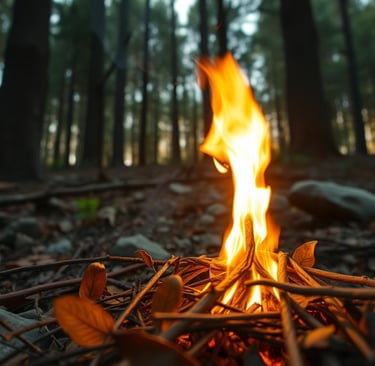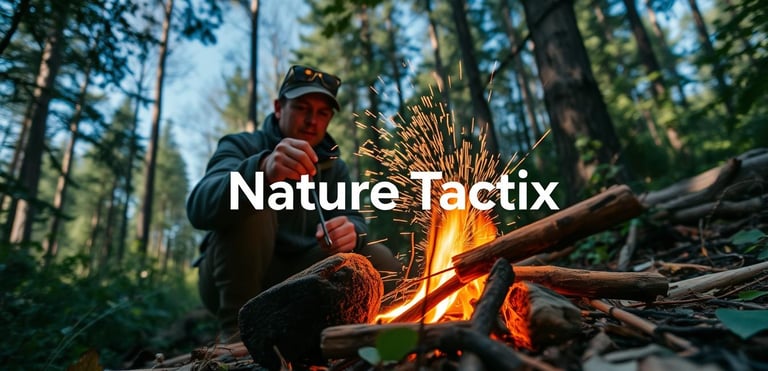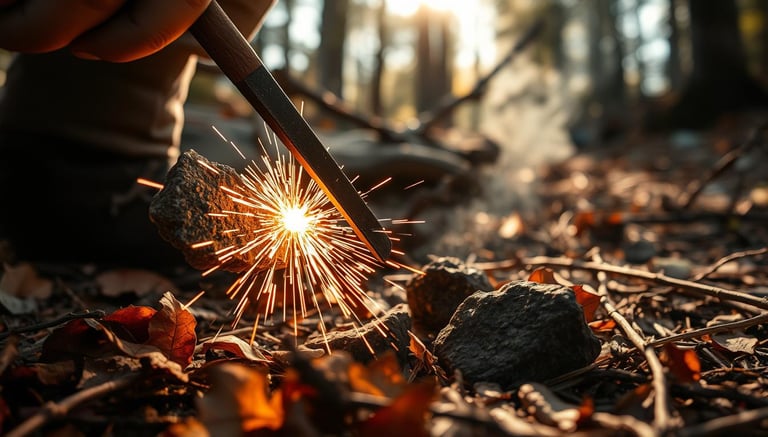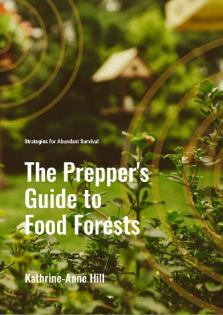Fire Starting in the Wilderness: Survival Skills
Fire Starting in the Wilderness. Discover essential fire starting techniques for wilderness survival. Learn how to build a campfire, find tinder, and stay safe in the Canadian backcountry.
SURVIVAL POSTS
Kathrine-Anne Hill
10/20/202413 min read


Affiliate Disclosure:
Please note that some of the links in this article are affiliate links. This means that if you click on these links and make a purchase, I may receive a small commission at no additional cost to you. This commission helps support the maintenance and growth of this website and allows me to continue providing valuable information and recommendations. Rest assured, I only recommend products and services that I have personally used or thoroughly researched. Your support is greatly appreciated! “As an Amazon Associate I earn from qualifying purchases.” For full disclosure see our Privacy Policy and Terms and Conditions here.
Fire Starting in the Wilderness: Survival Skills
Did you know you can only survive 3 days without water in a survival situation1? Learning to start a fire is key for outdoor lovers. It gives you warmth, light, and a way to clean water and cook food. In Canada's backcountry, knowing how to start and keep a fire can save your life1.
In this guide, I'll show you how to start a fire in the wilderness. You'll learn both old and new ways to light a fire, even when it's hard2.
Key Takeaways
Fire is a crucial survival skill that provides warmth, light, and a means to purify water and cook food.
Mastering a range of fire-starting techniques, from primitive methods to modern tricks, is essential for outdoor enthusiasts.
Proper preparation of tinder, kindling, and fuel wood is key to building and maintaining a sustainable fire.
Understanding the principles of airflow and fire pit construction can help you create an efficient and controlled fire.
Safely extinguishing and maintaining a fire is just as important as starting one in the first place.
Gathering Tinder and Fuel
The first step in building a successful fire in the wilderness is gathering the right tinder materials and dry firewood. Tinder is the crucial ignition source that helps transform a spark into a flame. Ideal tinder includes dry leaves, pine needles, grass, and small twigs, as they ignite easily3. To sustain the fire, you'll need larger sticks and logs as the main fuel source. It's essential to collect only dry, dead wood, as wet or green materials will be difficult to light3.
Understanding Tinder Materials
When selecting tinder, aim to create a ball the size of a basketball when packed tightly3. This ample amount of tinder will give you the best chance of successfully lighting a fire, even in challenging conditions. Common tinder materials like birch bark, red pine needles, and shredded inner bark work well, as they catch a spark and sustain a flame4.
Collecting Dry Firewood
You'll need tinder and dry firewood to start a fire. Collect a good amount of kindling, from thin sticks to thicker logs3. Start with small kindling that burns hot before adding bigger logs3.
This method keeps the fire burning well and prevents it from being smothered4.
Having enough tinder and dry firewood is crucial for starting a fire in the wilderness34. Gathering these materials carefully will help you build a lasting campfire5.
Building a Fire Pit
Building a fire pit needs careful planning. The pit should be 2 feet in diameter for 1-3 people or 3-4 feet for more6. It should be 3 to 8 inches deep at the center for better burning and less smoke6.
Use stones that haven't been in water to avoid explosions6.
Preparing the Fire Pit
Clear the area of anything flammable before starting the fire. This step helps prevent the fire from spreading and reduces the risk of wildfires6. A heat reflector, like a natural feature or a built wall, keeps the heat in and protects the fire from wind6.
A small bump in the fire ring can be used for cooking, making meal prep easy6.
Creating a Draft for Air Flow
Good air flow is essential for a successful fire. A draft ensures efficient burning and a longer fire. Softwoods like pine are great for kindling, while hardwoods like oak, maple, and cherry burn hotter and cleaner6.
Different wood arrangements, like the Tepee or Log Cabin, improve air flow and burning efficiency7.
With careful planning, you can build a safe and functional fire pit. It will provide warmth, cooking, and a comfortable backcountry experience67.
Friction-Based Fire Making
Starting a fire using friction is both challenging and rewarding. It needs patience, practice, and the right tools. The hand drill and bow drill are two common methods8.
The Hand Drill Method
The hand drill uses a wooden spindle and a fireboard to create heat. You spin the spindle in a notch to make a spark. It's an ancient method that requires a steady hand and focus8.
The Bow Drill Technique
The bow drill uses a bow and socket to apply pressure. This creates an ember from the spindle's rotation. It's seen as a reliable method for starting a fire in the wild8.
Both methods need dry, softwood materials to work. Cedar, poplar, aspen, or basswood are good choices. The spindle should be 8 inches long and the fireboard should be medium-hard wood8.
Preparing the tinder bundle is key. Use cedar bark, dry grass, or cattail down. These materials catch fire easily8. The bow should be strong and slightly bent, with a sturdy connection8.
Learning friction-based fire making takes time. But, the feeling of success and the skill gained are worth it. With effort, the hand drill and bow drill can be your go-to fire-starting tools9.
Fire Starting in the Wilderness
Learning to start a fire in the wilderness is key for survival. It's vital for emergencies or outdoor fun10. Knowing how to start a fire, even when it's damp, can be a lifesaver.
Choosing the right fuel is crucial10. Soft woods burn lower than hard woods. Some trees, like tamarack or birch, have special uses10. It's important to know how to find and use the right materials.
Starting a fire can be done in many ways. You can use old methods like bow drills10 or modern tools like Ferro rods10. Even battery-powered steel wool can start a fire11. You can also use fungus and pine needles10. On sunny days, a magnifying glass can focus the sun to start a fire10.
It's key to practice fire starting before venturing into the wild11. With the right skills, you can start a fire anywhere. This keeps you safe and warm12.
"The ability to start a fire in the wilderness can be the difference between life and death in an emergency situation."
Using Flint and Steel
Starting a fire in the wilderness with a flint and steel is reliable. Striking the steel against flint creates sparks. These sparks can be caught in char cloth or tinder13. When done right, flint sparking works about 92% of the time13.
The Prepared4X Fire Starter Tool is easy to use and works even if it has soaked in water.
Improvising with Rocks and Metal
Without a flint and steel set, you can still start a fire. Use quartzite rocks and a sharp knife or metal tool14. Quartzite and chert are good rocks for this14. It's not as good as a proper kit, but it works in survival situations.
Utilizing Char Cloth or Natural Alternatives
Char cloth is a fantastic fire starter. It's made by heating fabric in no oxygen14. It becomes black and brittle14.
There are two ways to catch sparks with char cloth. But one method is not very reliable14.
Other fire starters include charred fungus, punk wood, and dried fungus15.
"Starting a fire with flint and steel is a skill still widely practiced by re-enactors of historical events such as the French and Indian War, the Revolutionary War, and the American fur trade."15
Flint and steel can start a fire, but it's not always easy15. The author doubts its reliability for survival. They prefer disposable lighters for their convenience15.
Lens-Based Fire Starting Methods
In the wilderness, matches and lighters might be hard to find. But, using the sun's rays can change the game for starting fires. Methods like using a magnifying glass or eyeglasses' lenses are reliable and effective for igniting tinder and starting your campfire16.
Traditional Lenses: Magnifying Glass and Eyeglasses
A magnifying glass is a classic tool for starting fires with the sun's rays. It focuses the sun's energy into a beam that can spark a flame17. Eyeglasses' lenses can also work as a makeshift lens for starting fires17.
Unconventional Lenses: Condoms, Balloons, and Ice
Try using other lenses to start fires for a different approach. Water-filled balloons or condoms can focus the sun's rays to ignite tinder17. Even clear ice can be shaped into a lens for starting fires in the wilderness17.
Lens-based fire starting is a unique and versatile way to use the sun's power. It's a valuable skill for wilderness survival. With practice and experimentation, you can learn to start fires with just the sun's rays and everyday items16.
Exploring different lens-based fire starting methods can improve your wilderness survival skills. It increases your chances of starting a fire, even in tough environments16.
"The key to successful lens-based fire starting is finding the right balance of lens, angle, and sunlight intensity. With a little practice, you'll be able to turn the sun's rays into a reliable source of ignition."
Whether you're experienced in wilderness survival or new to it, learning lens-based fire starting is empowering. It's a valuable skill for your survival toolkit16.
Innovative Techniques
There are new ways to start a fire besides the usual methods. One cool trick uses a soda can and a chocolate bar. You polish the can's bottom with chocolate to make a mirror. This mirror focuses the sun's rays to light a fire18.
Another smart trick uses a battery and steel wool. When you connect the battery to the wool, it heats up and can start a fire. This trick is great for starting fires without matches18.
Soda Can and Chocolate Bar Trick
The soda can and chocolate bar trick is a clever way to use the sun. By making the can's bottom shiny with chocolate, you create a mirror. This mirror focuses the sun's rays to light a fire. It's very useful when you don't have other fire-starting tools18.
Batteries and Steel Wool Method
Starting a fire with batteries and steel wool is smart. It heats the wool, which then ignites. This method is great for survival, as it doesn't need matches or lighters18.
"Knowing how to start a fire in the wilderness is a critical survival skill. These innovative techniques can make all the difference when faced with challenging conditions."
Cooking and Surviving with Fire
A campfire is more than just warmth. It's a lifesaver in the wild. Learning to make fire opens up many ways to cook, purify water, and even signal for help19.
Boiling water over a fire makes it safe to drink. It kills harmful bacteria and pathogens19. When using a Dutch oven, place it on hot coals to avoid putting out the fire19.
Baking with fire involves creating a spot in the soil within the fire. Bury the food there with coals and ash, then cover it with more coals and ash for gentle cooking19. Roasting and grilling over an open flame need careful monitoring to avoid soot on the food. Frying adds a delightful smoky flavor to your meals19.
A campfire can also be a beacon in an emergency, helping rescuers find you20. It can be used to cauterize wounds and deter predators, making it crucial for survival20.
But managing a fire requires diligence and responsibility. It's important to properly extinguish the flames and replenish the fuel supply. This ensures safety and prevents wildfires20.
Understanding fire's versatility and mastering its use can turn a wilderness challenge into an adventure1920.
Learning to make fire in the wilderness is a key skill. It can turn a survival situation into a fun outdoor adventure1920.
Maintaining and Extinguishing Fires
To keep a fire going in the wild, you need to pay attention and have enough fuel. Start by adding small, dry kindling to the fire. Then, add bigger wood pieces as it grows21. Be careful of rain or strong winds, as they can put out the fire fast. When it's time to stop the fire, do it safely and responsibly.
Replenishing Fuel Supply
It's important to have a steady supply of fuel for your fire. Look for dry, seasoned wood like small twigs, branches, and logs22. Always get more fuel than you think you'll need. This way, you can keep the fire going without starting a new one.
Safely Putting Out the Fire
When it's time to stop the fire, do it right. Use water or snow to put out the flames, and stir the ashes to find any hot spots21. Check the area for at least an hour after to make sure it's out. This stops the fire from starting again and lowers wildfire risks.
By following these steps, you can control your campfire or wilderness fire. This keeps it from being a danger to the area around it2122.
"Responsible fire management is not only about keeping warm and cooking, but also about preserving the delicate balance of the wilderness." - John Doe, Wilderness Survival Expert
Conclusion
Learning to start a fire in the wilderness is key for survival. This skill can save lives in emergencies. By knowing how to gather tinder and fuel, build a fire pit, and use friction-based methods, you'll be ready to start a fire in the Canadian backcountry23.
Anyone can become a skilled fire starter with practice and the right attitude. Outdoor preparedness and camping skills are key to staying safe and comfortable outdoors23. Mastering these techniques ensures your backcountry safety and allows you to enjoy the warmth and light of a fire.
Most wildfires are caused by human actions, including campfires and power line failures24. But, with careful planning and fire management, we can reduce these risks. Controlled burns and early-season fires help prevent harmful emissions and protect ecosystems23. By learning to start fires safely, we improve our survival skills and help the environment.
FAQ
What are the essential tinder and fuel materials for starting a fire in the wilderness?
To start a fire, dry leaves, pine needles, grass, and small twigs make excellent tinder since they ignite easily. Once the fire is going, larger sticks and logs serve as fuel. Always choose dry, dead wood, as wet or green wood won't catch fire effectively.
How do I properly prepare a fire pit before igniting the fire?
Before lighting a fire, clear the area around the fire pit of any flammable materials. Dig a shallow pit to contain the flames, and consider creating an air vent or tunnel to improve airflow, which helps the fire burn more efficiently.
What are the friction-based fire-starting techniques I can use in the wilderness?
One method is the hand drill, where you spin a wooden spindle in a notch to generate heat. Another is the bow drill, which uses a bow and socket to rotate the spindle and create an ember. Both techniques require dry, softwood to be effective.
How can I use flint and steel to start a fire in the wilderness?
By striking steel against flint, you can create sparks that ignite tinder. If flint and steel aren't available, you can use quartzite rocks and a knife instead. Char cloth, which is made by heating fabric, is also a reliable fire starter.
What are some unconventional fire-starting methods using everyday items?
You can use a soda can and chocolate to create a parabolic mirror that concentrates sunlight. Alternatively, a battery and steel wool can be used to start a fire, as the steel wool ignites when connected to the battery.
How do I maintain and extinguish a fire safely in the wilderness?
Begin with small, dry kindling and gradually add larger pieces of wood as the fire grows. Keep an eye on the weather, as rain or wind can extinguish the flames. To put out the fire, pour water over it, stir the ashes, and check for any remaining hot spots before leaving.
Source Links
5 Basic Survival Skills » Wilderness Awareness School - https://wildernessawareness.org/articles/5-basic-survival-skills/
Fire Starting Skills for Campers and Survivalists - https://blog.ucogear.com/fire-starting-skills-for-campers-and-survivalists/
Fire and Campfire Stories - The Fundamentals of Fire Starting - https://thesurvivaluniversity.com/survival-tips/fire-mastering-firestarting
How to Start a Fire with Only One Match in Difficult Conditions - https://survivalskills.guide/how-to-start-a-fire-with-only-one-match-in-difficult-conditions/
FIRE STARTING 101 – LESSON 4 – TIPS & TRICKS - https://blog.ucogear.com/fire-starting-101-lesson-4-tips-tricks/
Building a Fire Pit - https://www.wildernesscollege.com/building-a-fire-pit.html
How to Build a Campfire | The Ultimate Guide - https://koa.com/blog/how-to-build-the-perfect-campfire/
Learn how to create a fire by friction - Scouting magazine - https://scoutingmagazine.org/2019/10/create-fire-by-friction/
Primitive Fire Starting: the Bow Drill - https://www.instructables.com/Fire-without-matches-or-metal/
How to Start a Fire in the Wild With Nothing | Desert Island Survival - https://www.desertislandsurvival.com/how-to-make-a-fire/
Survival Fire Starters - https://www.wildernesscollege.com/survival-fire-starters.html
Survival Skills: How to Light a Fire in the Wilderness | Camotrek - https://camotrek.com/blogs/news/how-to-light-a-fire-in-the-wilderness/
How to Start a Fire Using Flint - https://www.instructables.com/How-to-Start-a-Fire-Using-Flint/
Flint and Steel Firemaking » Wilderness Awareness School - https://wildernessawareness.org/articles/flint-and-steel-firemaking/
Starting Fire with Flint and Steel – How It Works and Why It’s Not Really a Good Survival Plan - https://sensiblesurvival.org/2011/08/11/starting-fire-with-flint-and-steel-how-it-works-and-why-its-not-really-a-good-survival-plan/
9 Ways to Start a Fire Without Matches - https://www.artofmanliness.com/skills/outdoor-survival/9-ways-to-start-a-fire-without-matches/
How to Create Fire With a Magnifying Glass: A Beginner's Guide - https://www.wikihow.com/Create-Fire-With-a-Magnifying-Glass
How to build a fire in the wilderness - https://www.popsci.com/how-to-build-a-fire/
How to Cook Over a Fire, According to a Survival Instructor - https://www.backpacker.com/survival/how-to-cook-over-a-fire/
Fire Starting 101 - Tom Brown III - Anchored Outdoors - https://anchoredoutdoors.com/fire-starting-tom-brown/
Building and Extinguishing a Fire - https://www.offroad-ed.com/newhampshire/studyGuide/Building-and-Extinguishing-a-Fire/40103101_172150/
Campfire | Build, start, maintain, extinguish, LNT | The Hiking Life - https://www.thehikinglife.com/hiking-and-backpacking-skills/fire/
The Ecological Benefits of Fire - https://education.nationalgeographic.org/resource/ecological-benefits-fire/
Understanding How Wildfires Start: Natural and Human Causes - https://www.dryad.net/post/how-do-wildfires-start










The Prepper's Guide to Food Forests: Strategies for Abundant Survival is a concise, step-by-step guide to creating a self-sustaining food forest. Ideal for preppers, it covers essential topics like design, plant selection, permaculture, companion planting, and wildlife integration. Learn how to maintain your forest, boost yields, and make it part of your survival strategy.
Highlights:
Basics of food forests and their benefits
Designing and selecting resilient plants
Creating a self-sustaining ecosystem
Using permaculture and companion planting
Maintenance, harvesting, and wildlife habitats
Food forests as part of a prepper strategy
Perfect for anyone seeking long-term food security.
Sign-Up and receive my FREE eBook The Prepper's Guide to Food Forests: Strategies for Abundant Survival !
As always, be sure to check our website for more wilderness tips and gear updates!
